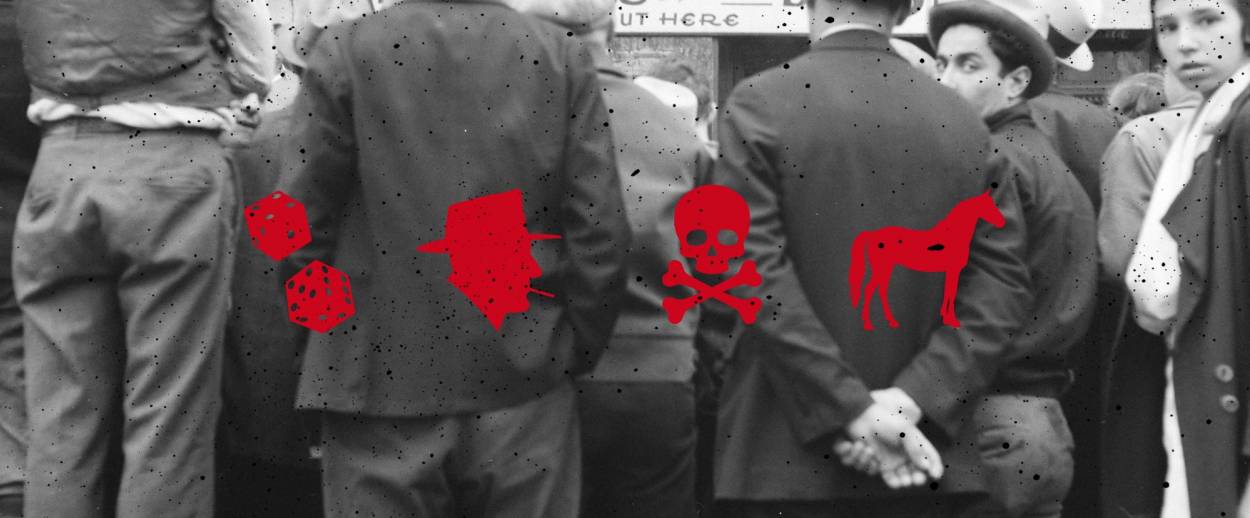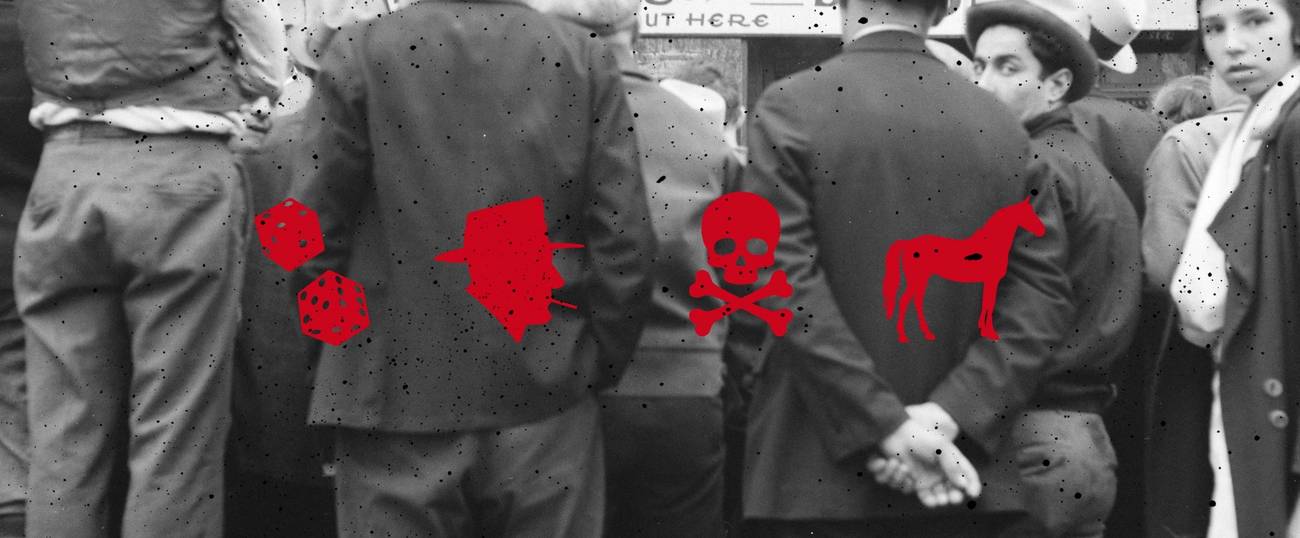The Horse-Poisoning Jewish Gangsters of the Lower East Side
An ugly New York City extortion racket at the turn of the last century




Once upon a time on the Lower East Side, the Jewish mob was as feared as the Mafia. Historian and Tablet contributor Jenna Weissman Joselit’s richly detailed Our Gang: Jewish Crime and the New York Jewish Community, 1900-40 and Rich Cohen’s Tough Jews spin stories of con jobs, brothels, gambling, and murder. Men and women who ran numbers and picked pockets shattered generations-old stereotypes of Jews as effete intellectuals. All along the East River, as Cohen put it, “There were con artists, bunko men, crooked dealers in every kind of card game—Faro, Poker, Stud. There were thousands of gang members: Some joined because they wanted a family, some because they needed protection. There were pimps and hookers, loan sharks, opium dealers and addicts.”
Multiple walking tours celebrate this unsavory history, encouraging upstanding Jewish citizens to be titillated and horrified at the same time. I attended a tour called Kosher Nostra held by the Lower East Side Jewish Conservancy. Other Jewish thuggery strolls are hosted by NYC Gangster Tours, the Lower East Side History Project, and NYC Gangster Mob Tour. They touch on big names like Gurrah Schapiro; Bugsy Siegel; and Sam Levine, the shomer shabbos hitman. There was Monk Eastman, the Jewish gangster who might not even have been Jewish—he was listed as German in the census—but who felt that pretending to be Jewish would help him attract the best gang members. There was Abe “Kid Twist” Reles, who turned snitch and was thrown out the window of the Half Moon Hotel in Coney Island, despite being under police guard at the time. The tabloids called him “the canary who could sing but could not fly.” There were also lesser-known hoods like Stiff Rivka, who Joselit reports specialized in petty larceny during the Days of Awe. “She knows bible,” reported Abe Schoenfeld, a detective who worked for the Jewish community at the time, “and is well-versed in Judaism as any woman could be.” Stiff Rivka’s schtick was to dress up nicely, sit in the women’s section, scout out a bejeweled target, and pick her pocket as the synagogue emptied.
A lot of the physical markers of this era are gone. My tour guide, Rabbi David Kalb, warned the group, “A lot of this tour is going to be, ‘See that Baskin Robbins? That used to be …’” (The Baskin Robbins in question turned out to have been Ratner’s restaurant. The tour group, with many elderly participants, began collectively swooning over the onion rolls served in waxed paper.)
Back on track, we learned about the notorious Meyer Lansky, whose career in crime reportedly began with cholent. The story goes that every Friday afternoon, little Meyer was given the assignment of taking his mom’s cholent to the bakery, where it spent Shabbat with the neighbors’ pots, cooking until Saturday evening in a low oven. His mom would give him a nickel to pay the baker. But one day, the little boy stopped to watch the craps games on Delancey Street. He threw in his mother’s nickel. He lost, and his father made him eat the entire uncooked cholent. This was, it was said, his last gambling loss.
We gazed at the Jarmulowsky Bank Building, the first Jewish bank in New York City, on the corner of Orchard and Canal. The glorious beaux-arts edifice, with its ornate carvings and cartouches, was constructed in 1873. Lower East Side legend has it that the spire on top was built later, to ensure that the bank was taller than the Forward Building, because capitalism should trump socialism. Its founder, Sender Jarmulowsky, was an upstanding businessman, Torah scholar, and the first president of the Eldridge Street Synagogue. Alas, his sons Louis and Meyer were bums. When they took over the bank in 1912, they began raiding its coffers, and when WWI broke out and families rushed to get out their money to try to save relatives abroad, they discovered it was all gone. A 3,000-person mob stormed the bank, and another 500 descended on Meyer’s house. He fled via the roof, jumping from building to building. He was caught, and the Jarmulowsky boys were indicted for bank fraud.
The building, vacant for years, has now been restored to its former glory. In August, a gleaming, 2,200-pound copper lantern was hoisted via giant crane to the top of the building; like pretty much every pretty building on the Lower East Side that is not a luxury condo, it is being turned into a luxury hotel.
Another son who destroyed the reputation of his upstanding father was Arnold Rothstein, who came from uptown money and education. His father, known as Abe the Just, was a philanthropist and chairman of the board of Beth Israel Hospital. Arnold’s brother Harry became a rabbi. But Arnold became “the JP Morgan of the underworld.” As a teenager, Arnold perpetually sneaked down to Orchard and Rivington on erev Shabbat to play cards all night, then fell asleep in synagogue on Saturday morning. He grew up to marry a non-Jew, the glamourous Carolyn Green; Abe sat shiva.
For Arnold, criminality was corporate. The model for Meyer Wolfsheim in The Great Gatsby and Nathan Detroit in Guys and Dolls, he was a flashy dresser who made gambling chic. He smuggled liquor and narcotics and built fancy, upscale dens of sin where Jewish millionaires from all over whiled away their hours and dollars. (The Forward referred to “slick, vapid young swells” like Julius “The Yeast King” Fleischmann and Canadian liquor heir Joseph Seagram as “PHGs,” which stood for “Papa Has Gelt.”)
Arnold’s career and life ended with a meeting gone bad at the Park Central Hotel. Shot in the abdomen, he refused to tell the police who did it when they asked. Some reports say he replied, “Come on, you know me better than that.” Other reports had him say, “My mudder did it.”
But my favorite Lower East Side gangster story is that of the Yiddish Black Hand, a gang founded in 1906 and headed up by Jacob “Johnny” Levinsky, Charles “Charley the Cripple” Vitoffsky, and Joseph Toblinsky. (Toblinsky’s nickname is unprintable today. A dark-skinned man, he was known as “Yosky” followed by the N-word.) They named themselves after the original Black Hand, Italian gangsters who’d been in the extortion racket in NYC since the 1880s. When you’re starting an extortion ring, it’s always good to capitalize on a name that’s already scaring people.
The term “black hand” originally referred to heavy black handwritten threats. While the Italians specialized in kidnappings, the Yiddish Black Hand cornered the market on horse-poisonings. (Horse-poisoning and arson were the two crimes Jews had an effective monopoly on, Joselit notes.) The way the scheme worked: The Yiddish Black Hand would demand a “tax” or “tribute” in exchange for protection. That protection, of course, was from the Yiddish Black Hand itself. In the parlance of the day, they’d threaten, “pay or we’ll drop a horse on you,” Joselit writes.
The Yiddish Black Hand’s headquarters was a saloon at 21 Suffolk Street. Opened in 1904, the saloon was owned by Max Schnur (and “fitted up in a good style,” according to the Tammany Times), who surely knew what was going on in his establishment. Not only did the trio write their extortion letters there, but their lackeys picked up the notes there and the quaking “clients” returned there to deliver cash.
Each of the three gang leaders took on a different industry to threaten: Levinsky extorted from the ice cream makers; Toplinsky was produce and livery; and Vitoffsky was seltzer.
Horse-poisoning proved effective and lucrative; Toblinsky alone purportedly poisoned 200 horses. By 1912 the Yiddish Black Hand was poisoning 12 horses a week. (According to one tour guide, you could also hire the Hand to poison your rival’s horses; the cost was $35 for one horse and $50 for a team of two, clearly a bargain.) Eventually local businesses created a community fund to pay off the mobsters. Still, the problem continued. It got so bad that the merchants formed the East Side Horse Owners Protective Association and became police informants, despite the fact that snitches get stitches. Several members of the gang—Joselit reports that it was small, only about a dozen people—were locked up. By 1913 the threat of the Yiddish Black Hand was over.
It’s easy to romanticize the despicable behavior of long-dead people. Movies, with their wise guys in fedoras and sharp lapels, gun molls with marcelled hair, and cute pickpocketing urchins in tweed caps, have encouraged it. But sexual slavery and murder aren’t cute. Little kid crooks were, as Cohen put it, “underfed, illiterate, disease-ridden, and mean. They lived three-to-a-bed in tenement flops, stalked the streets, and drank turpentine on a dare.” Poor girls coming to the U.S. in hopes of a better life were swept up by sweet-talking pimps at Castle Garden (the city’s immigration center from 1855 to 1890, before Ellis Island opened—it’s now known as Castle Clinton). They’d claim to be affiliated with a Jewish benevolent organization and instead lure the girls into prostitution.
My tour guide offered a theory about why we Jews glamorize our own tawdry history. “Between 70 CE and 1948, there was little Jewish power,” Kalb observed. “One of the few examples of Jewish power in that era is gangsters. They’re evil, but they’re appealing because they’re not victims. Now we’ve entered an era of Jewish power, in both the USA and Israel. The question is: How do we use that power well?”
As with most Jewish questions, the answer varies widely from Jew to Jew. We can probably all agree, though, that horse-poisoning is a “never again” deal.
***
Like this article? Sign up for our Daily Digest to get Tablet magazine’s new content in your inbox each morning.
Marjorie Ingall is a former columnist for Tablet, the author of Mamaleh Knows Best, and a frequent contributor to the New York Times Book Review.